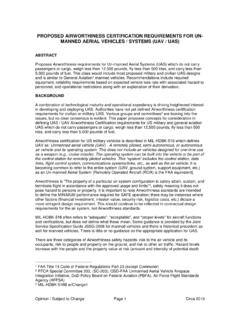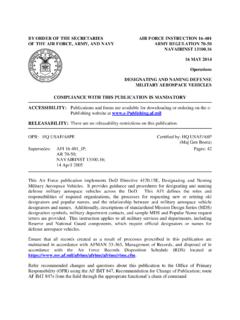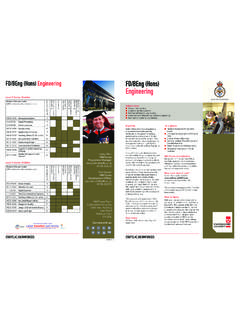Transcription of Section Trends Concerning Military Science and …
1 113 Chapter 2 Issues in the International CommunityDefense of JapanSection 6 Trends Concerning Military Science and Technology as well as Defense Production and Technological BasesTrends Concerning Military Science and Technology as well as Defense Production and Technological BasesSection6 1 Military Science and Technological TrendsRecent developments in Science and technology, in particular the dramatic advancement of Information and Communication Technology (ICT), has impacted a variety of areas, triggering signi cant, revolutionary changes in many areas such as economy, society, and Military is no exception. Advanced countries, includ-ing the , take the transformation triggered by the devel-opment of ICT as a factor enabling the dramatic improvement of combat and other capabilities, and continue to engage in a variety of research and particular, the focuses on Network-Centric Warfare (NCW) as the direction for transformation of its armed forces.
2 NCW captures information on enemy troops using informa-tion-gathering systems, including reconnaissance satellites and unmanned aircraft. The information is then shared on networks, enabling immediate command and control, even from remote headquarters; and enforces fast, precise, and exible attacks against targets. This ensures further superiority in combat rec-ognition capabilities in war space, as well as achieving more ef cient combat development of various media encompassing television, newspapers, and the Internet including social media, has enabled combat and damage situations to be broadcast across the world in real time, tending to make casualties caused by ghting and other events greatly impact society. This has required countries to minimize casualties of citizens and their own forces on the battle eld.
3 In response to these social Trends , precise and effective attacks dedicated to Military targets are required, and countries maintaining high-tech troops, including the , work on improving the destructive capabilities of their weapons, precision guidance technology, information-related technology including C4 ISR, and unmanned technology ( drones) to be able to carry out more precise and effective attacks. They also make emphasis on research and development activities on improved stealth capacity to increase opportunities for preemptive attacks, stealth technology for reducing risks for attrition of combat capabilities through improved survivability, and nanotechnology used for parts and materials related to these technologies. The Quadrennial Defense Review (QDR), published by the Department of Defense in March 2014, states that the proliferation of state-of-the-art technologies1 will transform the mode of advancements in Military Science and technology are also largely attributed to the advancement of civil technology.
4 As the capabilities of existing equipment are improved and new equipment is developed, spin-on and dual-use technology2 based on civil technology have recently been leveraged frequently. In particular, ICT-related civil technology has been applied to a variety of equipments on a larger scale. The has a signi cant edge in the area of these state-of-the-art technologies, and it is being pointed out that the gap in Military capabilities with its allies could constrain any joint the other hand, countries having dif culty in possess-ing high-tech troops for technological and economic reasons, and non-state entities including terrorist organizations, will work on research and development on weapons and other equipment that will enable them to gain superiority in ghting against countries with state-of-the-art technology, and to ille-gitimately obtain technology through ICT or other means.
5 In short, these countries and organizations tend to focus on asym-metrical combat measures that can be developed or obtained with relatively less cost, enabling them to attack their oppo-nents vulnerability without using conventional Military capa-1 The QDR describes that such technologies include counter-stealth technology that used to require large budgets, automated and autonomous systems as well as robotics that already have a wide range of commercial and Military applications, low-cost three-dimensional printers that could revolutionize weapons manufacturing and logistics related to warfare, and biotechnology breakthroughs that could make new ways of developing weapons of mass destruction possible. The report notes that it remains unclear how these technologies will manifest on the battlefi In the fi eld of Military technology, generally speaking, spin-on means applying civil technology into Military technology, spin-off means technology application in the opposite direction, and dual-use technology means technology available for use in both Defense Advanced Research Projects Agency (DARPA) conducts research on a variety of Military technologies.
6 (DARPA website)114 Issues in the International CommunityChapter 2 DEFENSE OF JAPAN 2014 Part I Security Environment Surrounding Japanbilities. These asymmetrical combat measures include weapons of mass destruction, such as nuclear, chemical, and biological weapons; ballistic missiles; terrorist attacks; and cyber forward, advanced countries, including the United States, are likely to continue to further develop their state-of-the-art Military Science and technology. In contrast, countries and non-state entities pursuing asymmetrical combat measures will leverage civil technology and obtain technology in an ille-gitimate manner, to advance their level of Military Science and asymmetrical combat measures may be spreading throughout the world, the research and development of tech-nology3 that responds to these asymmetrical threats is also rec-ognized as an important challenge.
7 2 Trends Concerning Defense Production and Technological BasesRecently, Western countries have in particular been facing dif culty in signi cantly increasing their defense budgets. On the other hand, the sophistication of Military Science and technology and the greater complexity of equipment, as explained by 1 above, have escalated development and production costs and raised unit prices for procurement, resulting in a reduced number of procured units. Under these situations, many foreign countries are working on a variety of initiatives in order to maintain and enhance their national defense production and technological countries have targeted for greater competitive-ness, through realignment of their defense industry in response to the aforementioned situation related to national defense budgets. The has seen repeated mergers and integrations among domestic corporations, while Europe has experienced cross-border mergers and integrations of the defense industry, especially in Germany, France, the , and response to escalating development and production costs, Western countries are also promoting joint development and production and technological collaboration related to de-fense equipment among their allies and partners.
8 This move can be attributed to such factors as (1) splitting development and production costs, (2) expanding demands in all countries participating in joint development and production, (3) mutu-al complementarity of technologies, and (4) raising domestic technology levels by obtaining the latest , an international logistic support system called Autonomic Logistics Global Sustainment (ALGS) was adopt-ed for the maintenance of the F-35 ghter aircraft, re ecting the international collaboration for its development. This system en-ables all F-35 user countries to share its components globally. It is important to pay close attention to the establishment of such international frameworks for logistic support, and the progress of international joint development and Part IV, Chapter 1, Section 4-3 (Technological Cooperation with Insti-tutions Overseas and Within Japan)See Fig.
9 I-2-6-1 (Examples of International Joint Development)Many foreign countries have been exporting defense equipment overseas since the Cold War era, and many countries have recently been promoting a policy of overseas exporting. As defense equipment has faced a dramatic increase in its 3 They include BMD as well as technologies for countering ballistic missiles, terrorist attacks, cyber attacks, etc. as well as Large corporations involved with the defense industry of Western countries have high defense business ratios in their total revenues. In particular, the and the have large corporations with most of their revenues attributed to the defense business. Fig. I-2-6-1 Examples of International Joint DevelopmentEquipmentYear development commencedYear of unit deploymentParticipating countriesTransport aircraft (A400M) 198220138 countries including , France, Germany, Italy, and Spain (the withdrew by 2003)Fighter aircraft (Euro fi ghter) 19862003UK, Germany, Italy, and SpainFighter aircraft (F-35) 2001 Unit not yet in operation9 countries including , , the Netherlands, and ItalyUnmanned aircraft (Euro Hawk) 2005 Joint development , GermanyUnmanned aircraft (nEUROn)
10 2005 Unit not deployed6 countries including France, Sweden, Italy, and Spain115 Chapter 2 Issues in the International CommunityDefense of JapanSection 6 Trends Concerning Military Science and Technology as well as Defense Production and Technological Basesdevelopment and production costs, countries intend to maintain and strengthen their domestic defense industry by expanding demands in foreign markets through overseas exports, and seem to leverage this as a certain diplomatic tool for expanding their in uence in the export destination countries. In addition, countries such as China and the Republic of Korea have established the infrastructure required to manufacture weapons through their past imports of defense equipment and their improved capabilities in Science and technology, enabling them to attain the status of an export country of affordable defense equipment and to increase their export have recently seen an increase of defense equipment exports targeting the Asia-Paci c region.
















